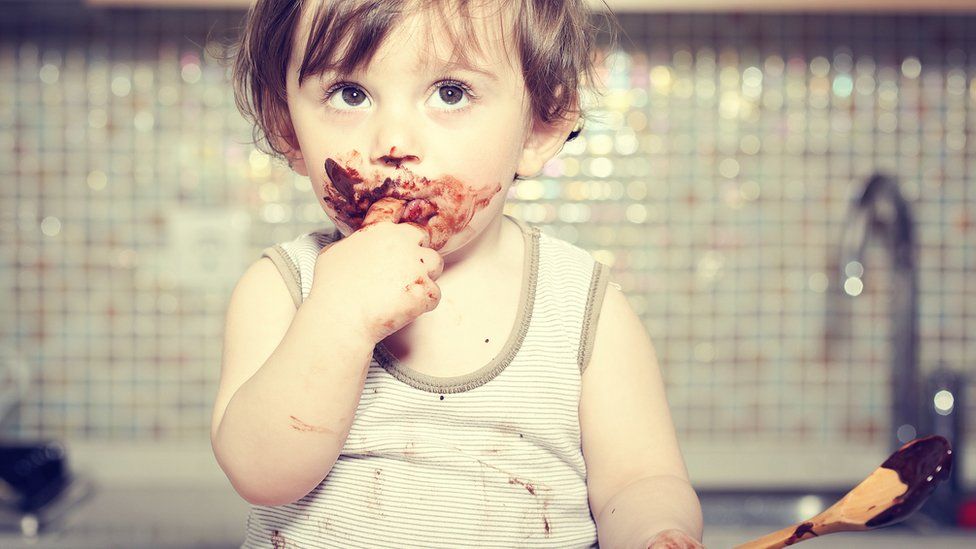The secret of why we like to eat chocolate
- Published

It may seem simple - we like chocolate because it tastes nice. But there's more to it than that - and it relates to a fat/carbohydrates balance that is set right from the very beginning of our lives.
I love chocolate and once I start on a bar I can't stop until it's all gone. One square, or even a few, are never enough. My family know that if they bring chocolate into our house they will have to hide it.
So what is it about the food that so many of us find irresistible? And what characteristics does chocolate share with other foods that we simply can't say, "no" to?
As part of a new series on the science of food, botanist James Wong and I went looking for answers.
'Lemonade and a custard apple'
Chocolate is made from cocoa beans, which have been grown and consumed in the Americas for thousands of years.
The Maya and the Aztecs made a drink out of cocoa beans called xocolatl, which means "bitter water."
That's because in its raw form cocoa beans are intensely bitter.
To get at the beans you first have to crack open the thick husk of the cocoa pod, releasing a pulp that has an intense tropical flavour that's halfway between lemonade and a custard apple. Known as baba de cacao, it's sweet, acidic and very sticky.
The beans and pulp are then sweated and allowed to ferment for several days before being dried and roasted.
Roasting releases a range of chemical compounds including 3-methylbutanoic acid, which on its own has a sweaty rancid odour, and dimethyl trisulfide, the smell of over-cooked cabbage.
The combination of these and other aroma molecules creates a unique chemical signature that our brains love.
But the rich, chocolaty smells and the happy memories of youth that those smells provoke, are just part of chocolate's attraction.
Chocolate contains a number of interesting psychoactive chemicals. These include anandamide, a neurotransmitter whose name comes from the Sanskrit - "ananda", meaning "joy, bliss, delight". Anandamides stimulate the brain in much the same way that cannabis does.
It also contains tyramine and phenylethylamine, both of which have similar effects to amphetamines.
Finally, if you look hard enough, you will find small traces of theobromine and caffeine, both of which are well-known stimulants.
For a while, some food scientists got very excited about the discovery but to be honest, although chocolate contains these substances, we now know they are only there in trace amounts.
Your brain is not going to get much of a chemical rush from eating a few squares. None the less, they may play a small part in seducing our senses.
Sugars plus fats
So what else does chocolate have going for it?
Well, it also has a creamy viscosity. When you take it out of its wrapper and put a bit in your mouth without biting, you will notice that it rapidly melts on your tongue, leaving a lingering sensation of smoothness.
Special touch receptors on our tongues detect this textural change, which then stimulates feelings of pleasure.
But the thing that really transformed the cocoa from a bitter and watery drink into the snack we adore today was the addition of sugar and fat.
The addition of just the right amount of each is crucial to our enjoyment of chocolate. Look at the side of a packet of milk chocolate and you will see that it is normally contains around 20-25% fat and 40-50% sugar.
In nature such high levels of sugar and fat are rarely found, or at least not together.
You can get lots of natural sugars from fruits and roots, and there is plenty of fat to be found in nuts or a tasty chunk of salmon, but one of the few places where you will find both together is in milk.
Human breast milk is particularly rich in natural sugars, mainly lactose. Roughly 4% of human breast milk is fat, while about 8% is made up of sugars. Formula milk, which is fed to babies, contains a similar ratio of fats to sugars.
This ratio, 1g of fat to 2g of sugars, is the same ratio of fats to sugars that you find in milk chocolate. And in biscuits, doughnuts, ice cream. In fact this particular ratio is reflected in many of the foods that we find hard to resist.
So why do I love chocolate? For a whole host of reasons. But it may also be that I, and chocoholics like me, are trying to recapture the taste and sense of closeness we got from the first food we ever sampled; human breast milk.
The Secrets of Your Food begins on BBC2 at 2100GMT on Friday February 24th.
Join the conversation on our Facebook page.
- Published13 February 2017
- Published20 February 2017
- Published1 December 2016